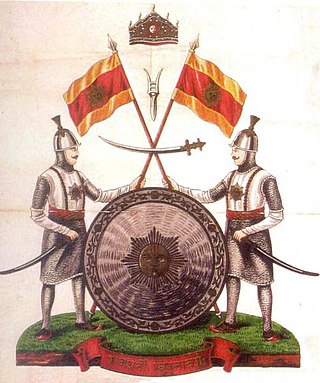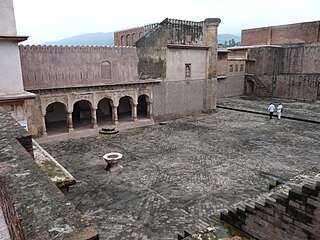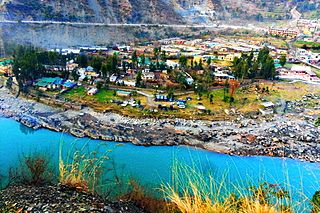The Dogras or Dogra people, are an Indo-Aryan ethno-linguistic group living primarily in the Indian union territory of Jammu and Kashmir and neighbouring Pakistan, consisting of the Dogri language speakers. They live predominantly in the Jammu region of Jammu and Kashmir, and in adjoining areas of Punjab and Himachal Pradesh. Some also live in northeastern Pakistan. Their historical homeland is known as Duggar.

Raghunath Temple is a Hindu temple located in Jammu in the Indian union territory of Jammu and Kashmir. It consists of a complex of seven Hindu shrines. Raghunath Temple was constructed by the first Dogra ruler Maharaja Gulab Singh in the year 1835 and later his son Maharaja Ranbir Singh got it completed in the year 1860 During Dogra rule. The temple has many gods in its complex of shrines, but the presiding deity is Rama – also known as Raghunath, an Avatar of Vishnu. All the spiral-shaped towers have gold plated spires. The niches in the walls of the shrines are decorated with 300 well-crafted icons of gods and goddesses including those of Surya and Shiva, but most are particularly related to the life stories of Rama and Krishna. The paintings in the 15 panels of the main shrine are based on themes from Ramayana, Mahabharata, and Bhagavad Gita. The temple premises include a school and a library that preserves over 6,000 manuscripts in many Indian languages, with a notable collection of Sarada script Sanskrit manuscripts.
Ranbir Singh Pura is a town and nagar panchayat, near city of Jammu in Jammu district of the Indian Union territory of Jammu and Kashmir. It was the first planned city of Jammu and Kashmir

Bhimber is a town and the headquarters of the eponymous district in Pakistan-administered Azad Kashmir. The town and district are between the Jammu region of Indian-administered Kashmir and Pakistan proper, about 47 km (29 mi) by road southeast of Mirpur.

Ranbir Singh was Maharaja of Jammu and Kashmir from 1856 until his death in 1885.

Sir Pratap Singh was the Maharaja of Jammu and Kashmir, and head of the Jamwal Rajput clan.

Jamwal is a toponymic surname for a Dogra Rajput clan of the same name from Jammu, in Jammu and Kashmir, India. They claim descent from the traditional founder of Jammu, Jambu Lochan, and there at one time some of their members were rulers of the princely state of Jammu and Kashmir, often referred to as the Dogra dynasty.

Ramnagar is a town and notified area committee in Udhampur District in the Indian union territory of Jammu and Kashmir.

Ramban is a town in Ramban district of Jammu and Kashmir, India, which is the district headquarters of Ramban district. It lies on the banks of the Chenab river in Chenab Valley on the National Highway-1A at about 120 km from Jammu and about 130 km from Srinagar, making it almost the central point on the Jammu-Srinagar National Highway.

The Dogra dynasty of Dogra Rajputs from the Shivalik hills created Jammu and Kashmir through the treaties with the East India Company following the First Anglo-Sikh war. Events led the Sikh Empire to recognise Jammu as a vassal state in 1820, and later the British added Kashmir to Jammu with the Treaty of Amritsar in 1846. The founder of the dynasty, Gulab Singh, was an influential noble in the court of the Sikh emperor Maharaja Ranjit Singh, while his brother Dhian Singh served as the prime minister of the Sikh Empire. Appointed by Ranjit Singh as the hereditary Raja of the Jammu principality, Gulab Singh established his supremacy over all the hill states surrounding the Kashmir Valley. After the First Anglo-Sikh War in 1846, under the terms of the Treaty of Lahore, 1846, the Government of India acquired Kashmir from the Sikh Empire and transferred it to Gulab Singh, recognising him as an independent Maharaja. Thus, Jammu and Kashmir was established as one of the largest princely states in India, receiving a 21-gun salute for its Maharaja in 1921. It was ruled by Gulab Singh and his descendants till 1947.

Poonch District was a district of the princely state of Jammu and Kashmir, which is currently divided between India and Pakistan. The Pakistani part of the erstwhile district is now the Poonch Division in the Azad Kashmir territory, whilst the Indian part of the district is the Poonch district in Jammu and Kashmir. The capital of the Pakistan-controlled side is Rawalakot; while the capital of the Indian-controlled side is Poonch.
Presentation Convent Higher Secondary School is a selective K-12 independent day school for girls in Rajbagh, on the banks of Jhelum River, Srinagar. It was started in 1936 and run by the Sisters of the Blessed Virgin Mary, also known as Presentation Sisters. It was started to educate Dr. Karan Singh, then Crown Prince of the princely state of Jammu and Kashmir. It was started in 1936 by Mother Peter Conway, Mother Sacred Heart, Mother Annunciata, and Mother Xavier. The nuns travelled to Srinagar from Rawalpindi upon the request of the Maharaja Hari Singh.
BP Sharma was a journalist of Jammu and Kashmir, India, who was listed in the Limca Book of Records for becoming the oldest working journalist at the age of 92. He died in 2005 at the age of 97.

The history of Azad Kashmir, a disputed part of the Kashmir region currently administered by Pakistan, is related to the history of the Kashmir region during the Dogra rule. Azad Kashmir borders the Pakistani provinces of Punjab and Khyber Pakhtunkhwa to the south and west respectively, Gilgit–Baltistan to the north, and the Indian union territory of Jammu and Kashmir to the east. The region is claimed by India and has been the subject of a dispute between India and Pakistan since 1947.

Sher Garhi Palace is a former palace in Srinagar, Jammu and Kashmir, India. The complex is located in the south of the Old City at the banks of the Jhelum river. It was the residence of the Afghan rulers and Dogra Maharajas of Jammu and Kashmir.

Mubarak Mandi is a palace in the city of Jammu in Jammu and Kashmir, India. The palace was the royal residence of the maharaja of Jammu and Kashmir from the Dogra dynasty. It was their main seat till 1925 when maharaja Hari Singh moved to the Hari Niwas Palace in the northern part of Jammu. The palace is located in the heart of the old walled city of Jammu and overlooks the Tawi river. The architecture is a mix of Rajasthani architecture and European baroque, and Mughal styles. Successive maharajas added to the complex in size and building took more than 150 years.

The Jammu–Sialkot line was a 43 km (27 mi) broad gauge branch of the North Western State Railway from Wazirabad Junction, Punjab, to Jammu, passing through the Sialkot Junction. The section from Sialkot to Jammu (Tawi) was 27 miles (43 km) long, partly in the British Indian province of Punjab and partly in the princely state of Jammu and Kashmir Built in 1890 during the reign of Maharaja Pratap Singh, it was the first railway line in the state of Jammu and Kashmir.

The Jammu division is a revenue and administrative division of the Indian-administered Jammu and Kashmir in the disputed Kashmir region. It is bordered by the Kashmir division to the north. It consists of the districts of Jammu, Doda, Kathua, Ramban, Reasi, Kishtwar, Poonch, Rajouri, Udhampur and Samba. Most of the land is hilly or mountainous, including the Pir Panjal Range which separates it from the Kashmir Valley and part of the Great Himalayas in the eastern districts of Doda and Kishtwar. Its principal river is the Chenab.
Sri Pratap Higher Secondary is an all-boys school located at M.A. Road, Srinagar. It is one of the oldest school in Srinagar, locally known as S.P school. It was established in 1874 by the King of Jammu and Kashmir himself, Maharaja Ranbir Singh and is named after his successor Sri Pratap Singh. The school has risen from ranks starting as a middIe school then a high school after that becoming a higher secondary school and being elevated to the status of Model School by the state government. It is a selective school that offers admission on the basis of merit. The school has produced a line of distinguished alumni.
Dharmarth Trust in Jammu and Kashmir was founded by Maharaja Gulab Singh in 1846 as an endowment for religious charity, and to manage and support Hinduism. In 1884, and under Maharaja Ranbir Singh, the Ain-i-Dharmath or 'The Regulations for the Dharmarth Trust' were formulated and a government department for religious affairs was created. The trust helped the Dogra dynasty to consolidate and validate its control over its territory and over the functioning of Hinduism in the region.














